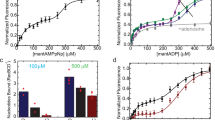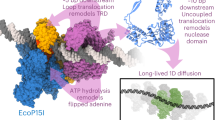Abstract
Major pathways of recombinational DNA repair in Escherichia coli require the RecBCD protein—a heterotrimeric, ATP-driven, DNA translocating motor enzyme. RecBCD combines a highly processive and exceptionally fast helicase (DNA-unwinding) activity with a strand-specific nuclease (DNA-cleaving) activity (refs 1, 2 and references therein). Recognition of the DNA sequence ‘χ’ (5′-GCTGGTGG-3′) switches the polarity of DNA cleavage and stimulates recombination at nearby sequences in vivo. Here we attach microscopic polystyrene beads to biotin-tagged RecD protein subunits and use tethered-particle light microscopy to observe translocation of single RecBCD molecules (with a precision of up to ∼30 nm at 2 Hz) and to examine the mechanism by which χ modifies enzyme activity. Observed translocation is unidirectional, with each molecule moving at a constant velocity corresponding to the population-average DNA unwinding rate. These observations place strong constraints on possible movement mechanisms. Bead release at χ is negligible, showing that the activity modification at χ does not require ejection of the RecD subunit from the enzyme as previously proposed; modification may occur through an unusual, pure conformational switch mechanism.
This is a preview of subscription content, access via your institution
Access options
Subscribe to this journal
Receive 51 print issues and online access
$199.00 per year
only $3.90 per issue
Buy this article
- Purchase on Springer Link
- Instant access to full article PDF
Prices may be subject to local taxes which are calculated during checkout




Similar content being viewed by others
References
Kuzminov, A. Recombinational repair of DNA damage in Escherichia coli and bacteriophage lambda. Microbiol. Mol. Biol. Rev. 63, 751 –813 (1999).
Kowalczykowski, S. C., Dixon, D. A., Eggleston, A. K., Lauder, S. D. & Rehrauer, W. M. Biochemistry of homologous recombination in Escherichia coli. Microbiol. Rev. 58, 401–465 (1994).
Gelles, J. & Landick, R. RNA polymerase as a molecular motor. Cell 93, 13–16 (1998).
Lovett, S. T., Luisi-DeLuca, C. & Kolodner, R. D. The genetic dependence of recombination in recD mutants of Escherichia coli. Genetics 120, 37–45 (1988).
Schafer, D. A., Gelles, J., Sheetz, M. P. & Landick, R. Transcription by single molecules of RNA polymerase observed by light microscopy. Nature 352, 444–448 (1991).
Yin, H., Landick, R. & Gelles, J. Tethered particle motion method for studying transcript elongation by a single RNA polymerase molecule. Biophys J. 67, 2468–2478 (1994).
Finzi, L. & Gelles, J. Measurement of lactose repressor-mediated loop formation and breakdown in single DNA molecules. Science 267, 378–380 (1995).
Roman, L. J. & Kowalczykowski, S. C. Characterization of the adenosinetriphosphatase activity of the Escherichia coli RecBCD enzyme: relationship of ATP hydrolysis to the unwinding of duplex DNA. Biochemistry 28, 2873–2881 (1989).
Roman, L. J. & Kowalczykowski, S. C. Characterization of the helicase activity of the Escherichia coli RecBCD enzyme using a novel helicase assay. Biochemistry 28, 2863– 2873 (1989).
Okada, Y. & Hirokawa, N. A processive single-headed motor: kinesin superfamily protein KIF1A. Science 283, 1152–1157 (1999).
Svoboda, K., Schmidt, C. F., Schnapp, B. J. & Block, S. M. Direct observation of kinesin stepping by optical trapping interferometry. Nature 365, 721–727 (1993).
Guajardo, R. & Sousa, R. A model for the mechanism of polymerase translocation. J. Mol. Biol. 265, 8-19 (1997).
Thaler, D. S. et al. in Mechanisms and Consequences of DNA Damage Processing (eds Friedberg, E. & Hanawalt, P.) 413–422 (Alan. R. Liss, New York, 1988).
Dixon, D. A., Churchill, J. J. & Kowalczykowski, S. C. Reversible inactivation of the Escherichia coli RecBCD enzyme by the recombination hotspot chi in vitro: evidence for functional inactivation or loss of the RecD subunit. Proc. Natl Acad. Sci. USA 91, 2980–2984 (1994).
Myers, R. S., Kuzminov, A. & Stahl, F. W. The recombination hot spot chi activates RecBCD recombination by converting Escherichia coli to a recD mutant phenocopy. Proc. Natl Acad. Sci. USA 92, 6244– 6248 (1995).
Stahl, F. W., Thomason, L. C., Siddiqi, I. & Stahl, M. M. Further tests of a recombination model in which chi removes the RecD subunit from the RecBCD enzyme of Escherichia coli. Genetics 126, 519–533 (1990); erratum ibid. 135, 1232 ( 1993).
Taylor, A. F. & Smith, G. R. Regulation of homologous recombination: Chi inactivates RecBCD enzyme by disassembly of the three subunits. Genes Dev. 13, 890–900 ( 1999).
Koppen, A., Krobitsch, S., Thoms, B. & Wackernagel, W. Interaction with the recombination hot spot chi in vivo converts the RecBCD enzyme of Escherichia coli into a chi-independent recombinase by inactivation of the RecD subunit. Proc. Natl Acad. Sci. USA 92, 6249–6253 (1995).
Anderson, D. G., Churchill, J. J. & Kowalczykowski, S. C. Chi-activated RecBCD enzyme possesses 5′→3′ nucleolytic activity, but RecBC enzyme does not: evidence suggesting that the alteration induced by Chi is not simply ejection of the RecD subunit. Genes Cells 2, 117– 128 (1997).
Dixon, D. A. & Kowalczykowski, S. C. The recombination hotspot chi is a regulatory sequence that acts by attenuating the nuclease activity of the E. coli RecBCD enzyme. Cell 73, 87–96 (1993).
Roman, L. J., Eggleston, A. K. & Kowalczykowski, S. C. Processivity of the DNA helicase activity of Escherichia coli recBCD enzyme. J. Biol. Chem. 267, 4207–4214 (1992).
Taylor, A. F., Schultz, D. W., Ponticelli, A. S. & Smith, G. R. RecBC enzyme nicking at Chi sites during DNA unwinding: location and orientation-dependence of the cutting. Cell 41, 153– 163 (1985).
Cronan, J. E. Jr Biotination of proteins in vivo. A post-translational modification to label, purify, and study proteins. J. Biol. Chem. 265, 10327–10333 (1990).
Boehmer, P. E. & Emmerson, P. T. Escherichia coli RecBCD enzyme: inducible overproduction and reconstitution of the ATP-dependent deoxyribonuclease from purified subunits. Gene 102, 1–6 (1991).
Eichler, D. C. & Lehman, I. R. On the role of ATP in phosphodiester bond hydrolysis catalyzed by the recBC deoxyribonuclease of Escherichia coli. J. Biol. Chem. 252, 499–503 (1977).
Young, E. C., Berliner, E., Mahtani, H. K., Perez-Ramirez, B. & Gelles, J. Subunit interactions in dimeric kinesin heavy chain derivatives that lack the kinesin rod. J. Biol. Chem. 270, 3926–3931 ( 1995).
Berliner, E. et al. Microtubule movement by a biotinated kinesin bound to streptavidin-coated surface. J. Biol. Chem. 269, 8610– 8615 (1994); erratum ibid. 269, 23382 (1994).
Anderson, D. G., Churchill, J. J. & Kowalczykowski, S. C. A single mutation, RecB(D1080A) eliminates RecA protein loading but not Chi recognition by RecBCD enzyme. J. Biol. Chem. 274, 27139–27144 (1999).
Berliner, E., Young, E. C., Anderson, K., Mahtani, H. K. & Gelles, J. Failure of a single-headed kinesin to track parallel to microtubule protofilaments. Nature 373, 718–721 (1995).
Taylor, A. F. & Smith, G. R. Strand specificity of nicking of DNA at Chi sites by RecBCD enzyme. Modulation by ATP and magnesium levels. J. Biol. Chem. 270, 24459– 24467 (1995).
Acknowledgements
We thank P. Bianco, P. Boehmer, S. Kowalczykowski, S. Lovett and A. Taylor for materials and helpful advice. This work was supported by the NIGMS.
Author information
Authors and Affiliations
Corresponding author
Supplementary information
41586_2001_BF35053124_MOESM1_ESM.mov
Quicktime video of a bead-labeled RecBCD-bio molecule translocating along a single DNA molecule. This experiment was performed as shown in Fig. 1 of the paper, except that the ATP concentration was reduced to 10 µM to slow translocation. The video is real time; the frame size is 6.5 µm wide by 6.6 µm tall. (MOV 1293 kb)
Rights and permissions
About this article
Cite this article
Dohoney, K., Gelles, J. χ-Sequence recognition and DNA translocation by single RecBCD helicase/nuclease molecules. Nature 409, 370–374 (2001). https://doi.org/10.1038/35053124
Received:
Accepted:
Issue Date:
DOI: https://doi.org/10.1038/35053124
This article is cited by
-
Rotation tracking of genome-processing enzymes using DNA origami rotors
Nature (2019)
-
Structural basis for translocation by AddAB helicase–nuclease and its arrest at χ sites
Nature (2014)
-
Allelic Variation in the Porcine MYF5 Gene Detected by PCR–SSCP
Molecular Biotechnology (2009)
-
Do-it-yourself guide: how to use the modern single-molecule toolkit
Nature Methods (2008)
-
Counting of six pRNAs of phi29 DNA-packaging motor with customized single-molecule dual-view system
The EMBO Journal (2007)
Comments
By submitting a comment you agree to abide by our Terms and Community Guidelines. If you find something abusive or that does not comply with our terms or guidelines please flag it as inappropriate.



